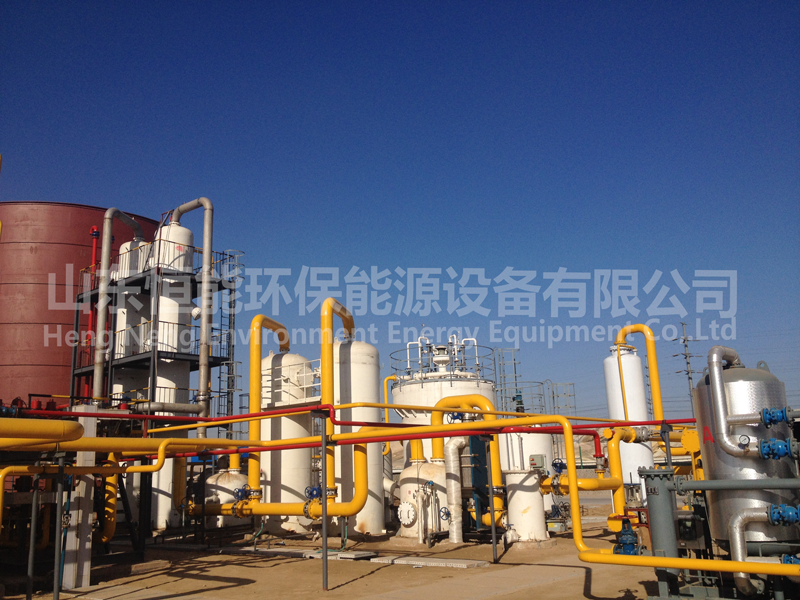歡迎進入山東恒能環保能源設備有限公司
歡迎進入山東恒能環保能源設備有限公司
沼氣脫硫罐是沼氣凈化系統的核心設備,其作用是通過物理或化學方法去除沼氣中的硫化氫等腐蝕性氣體,防止后續設備腐蝕并減少污染物排放。以下從內部結構、工作原理、技術優勢及應用場景四方面進行詳細解析。
The biogas desulfurization tank is the core equipment of the biogas purification system. Its function is to remove corrosive gases such as hydrogen sulfide from biogas through physical or chemical methods, prevent subsequent equipment corrosion, and reduce pollutant emissions. The following provides a detailed analysis from four aspects: internal structure, working principle, technological advantages, and application scenarios.
一、核心結構解析
1、 Core structure analysis
罐體與材質
Tank body and material
罐體通常采用碳鋼或不銹鋼材質,確保耐壓性與抗腐蝕性。例如,某專利設計的組裝式脫硫罐,罐體底部配置多組支腿與加強板,增強結構穩定性,頂部安裝電機與轉軸,驅動內部霧化噴頭實現脫硫劑均勻噴灑。
The tank body is usually made of carbon steel or stainless steel to ensure pressure resistance and corrosion resistance. For example, the assembled desulfurization tank designed by a certain patent is equipped with multiple sets of support legs and reinforcement plates at the bottom of the tank to enhance structural stability. A motor and shaft are installed at the top to drive the internal atomizing nozzle to achieve uniform spraying of desulfurizer.
填料層與脫硫劑
Packing layer and desulfurizer
填料層是脫硫反應的核心區域,填充氧化鐵顆粒或活性炭等脫硫劑。當含硫化氫的沼氣通過填料層時,發生催化氧化反應:
The packing layer is the core area of desulfurization reaction, filled with desulfurizing agents such as iron oxide particles or activated carbon. When hydrogen sulfide containing biogas passes through the packing layer, catalytic oxidation reaction occurs:
脫硫反應:Fe?O?·H?O + 3H?S → Fe?S?·H?O + 3H?O(放熱反應)。
Desulfurization reaction: Fe?O?·H?O + 3H?S → Fe?S?·H?O + 3H?O (exothermic reaction).
再生反應:2Fe?S?·H?O + 3O? → 2Fe?O?·H?O + 6S(需控制溫度以防自燃)。
Regeneration reaction: 2Fe?S?·H?O + 3O? → 2Fe?O?·H?O + 6S (temperature control is required to prevent spontaneous combustion).
填料層設計需兼顧氣體流速與接觸面積,確保硫化氫吸附效率。
The design of the packing layer should take into account both gas flow rate and contact area to ensure the efficiency of hydrogen sulfide adsorption.
噴淋與循環系統
Spray and circulation system
噴淋層位于填料層上方,通過循環泵將脫硫液(如堿性溶液)輸送至霧化噴頭,形成均勻水膜以優化反應條件。某實用型專利采用中空轉軸設計,脫硫液經轉軸內部流道輸送至多組霧化噴頭,提升噴灑均勻性。
The spray layer is located above the packing layer, and the desulfurization solution (such as alkaline solution) is transported to the atomizing nozzle through a circulating pump to form a uniform water film to optimize the reaction conditions. A practical patent adopts a hollow shaft design, and the desulfurization liquid is transported to multiple sets of atomizing nozzles through the internal flow channel of the shaft to improve the spraying uniformity.
除霧與排氣系統
Defogging and exhaust system
除霧層通過擋板與集水槽去除氣體夾帶的水滴,防止污染后續設備。排氣管采用耐腐蝕材料,確保凈化后的沼氣順暢排出,同時配置密封裝置防止泄漏。
The defogging layer removes water droplets carried by gas through baffles and collection tanks to prevent contamination of subsequent equipment. The exhaust pipe is made of corrosion-resistant materials to ensure the smooth discharge of purified biogas, and is equipped with a sealing device to prevent leakage.
二、工作原理與技術優勢
2、 Working principle and technological advantages
干法脫硫原理
Principle of dry desulfurization
干法脫硫利用固體脫硫劑的吸附與催化作用,在常壓下將硫化氫氧化為硫單質。其優勢包括:
Dry desulfurization utilizes the adsorption and catalytic action of solid desulfurizers to oxidize hydrogen sulfide to elemental sulfur at atmospheric pressure. Its advantages include:
投資與運行成本低:設備結構簡單,無需復雜配套系統。
Low investment and operating costs: The equipment structure is simple and does not require complex supporting systems.

脫硫精度高:可實現硫化氫濃度低于50mg/m3的凈化目標。
High desulfurization accuracy: can achieve hydrogen sulfide concentration below 50mg/m3 The purification goal.
操作便捷:填料更換周期長,維護工作量小。
Easy to operate: The filling replacement cycle is long and the maintenance workload is small.
濕法與生物法輔助
Wet and biological assisted methods
對于大型項目,常采用濕法粗脫硫(如氫氧化鈉溶液吸收)與干法精脫硫組合工藝,提升凈化效率。生物脫硫技術則通過微生物將硫化氫轉化為單質硫,運行成本低至每立方沼氣0.02元。
For large-scale projects, a combination of wet coarse desulfurization (such as sodium hydroxide solution absorption) and dry fine desulfurization processes is often used to improve purification efficiency. Biological desulfurization technology converts hydrogen sulfide into elemental sulfur through microorganisms, with an operating cost as low as 0.02 yuan per cubic meter of biogas.
三、應用場景與價值
3、 Application scenarios and value
養殖場與農業廢氣治理
Livestock farms and agricultural waste gas treatment
養殖場沼氣含硫化氫濃度高,直接燃燒會腐蝕設備并排放二氧化硫。脫硫罐可延長沼氣發電機組壽命,同時副產硫磺用于肥料生產。
The biogas in the breeding farm has a high concentration of hydrogen sulfide, and direct combustion can corrode equipment and emit sulfur dioxide. The desulfurization tank can extend the service life of biogas generators, while the by-product sulfur is used for fertilizer production.
工業廢水處理
Industrial wastewater treatment
污水處理廠沼氣需脫硫后才能用于鍋爐或發電機,避免腐蝕管道與燃燒設備。
The biogas from sewage treatment plants needs to be desulfurized before it can be used for boilers or generators to avoid corrosion of pipelines and combustion equipment.
燃料加工與能源利用
Fuel Processing and Energy Utilization
沼氣提純為生物天然氣時,脫硫是關鍵前處理步驟,確保符合車用燃料標準。
When biogas is purified into bio natural gas, desulfurization is a key pre-treatment step to ensure compliance with automotive fuel standards.
本文由沼氣脫硫友情奉獻.更多有關的知識請點擊:http://www.jxiuhui.com我們將會對您提出的疑問進行詳細的解答,歡迎您登錄網站留言.
This article is a friendly contribution from biogas purification For more information, please click: http://www.jxiuhui.com We will provide detailed answers to your questions. You are welcome to log in to our website and leave a message